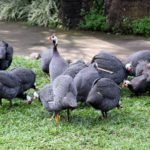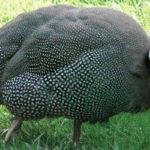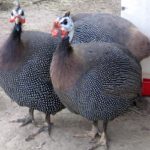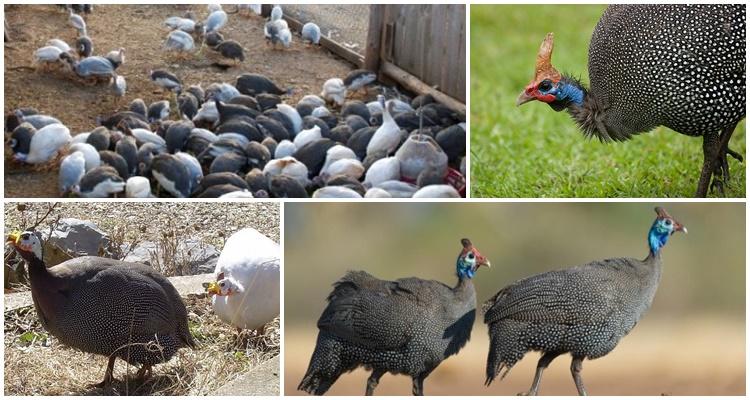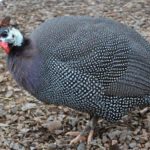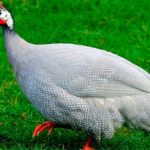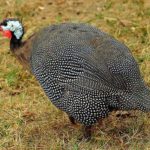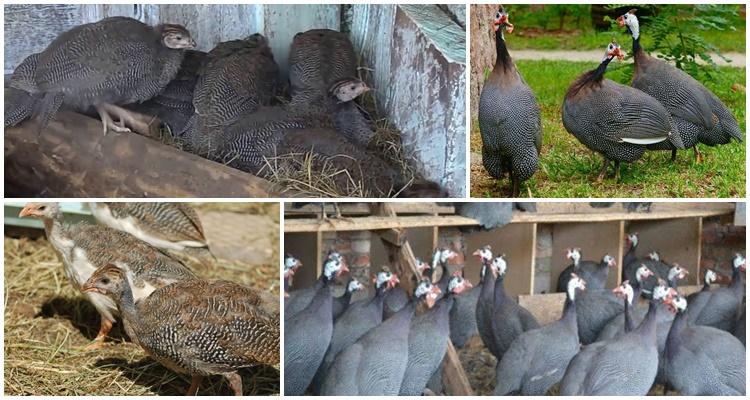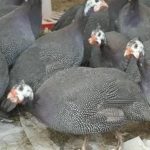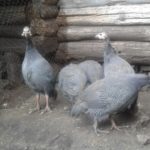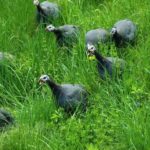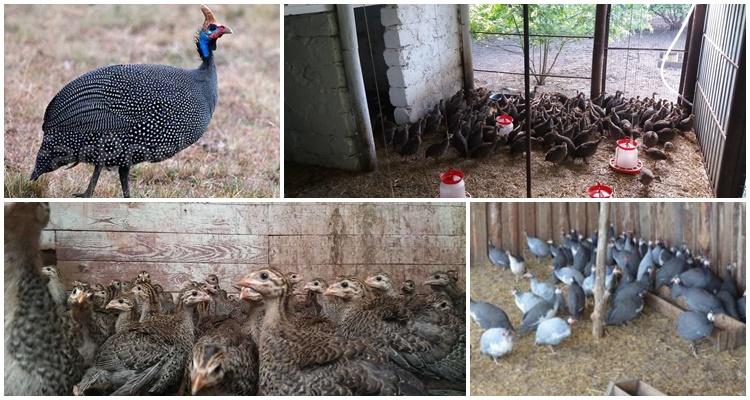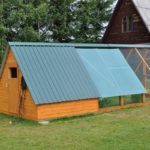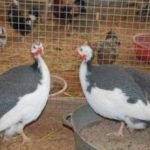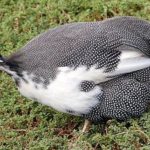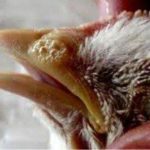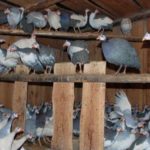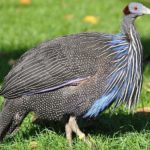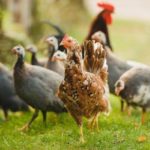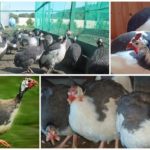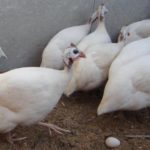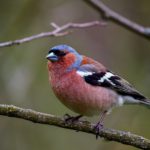For poultry breeders, quality characteristics are important. Such a species as broiler guinea fowl has earned positive ratings from farmers in different countries. The bird is valued for its unpretentiousness, calm nature, resistance to disease and high yields. In addition to its direct purpose, which involves obtaining tasty, high-quality meat, egg products can be reliably obtained from guinea fowl.
Origin and appearance features
Guinea fowl were bred by French breeders. The purpose of crossing species was to obtain birds of high meat quality. The result of the work was the appearance of guinea fowl with excellent external characteristics and the ability to produce up to 140 eggs annually. In addition to egg production, birds are famous for their excellent meat quality, as well as their ability to quickly gain weight.
Appearance of broiler guinea fowl:
| Characteristic | Description |
| Torso | The massive body is oval in shape, the height of an adult bird reaches 50 centimeters |
| Weight | Carcass weight reaches 4 kilograms |
| Coloring | Basic color shade – gray or pearl gray |
| Plumage | Dense feathering on the body, lack of feathering on the legs |
| Distinctive features | A dark growth and red bright earrings form on the head |
Information! In some guinea fowls, the area in the chest area has blue plumage.
Advantages and disadvantages
Broiler guinea fowl have their advantages and disadvantages. Among the advantages, farmers note the following characteristics:
- excellent quality of dietary meat, the taste is not lost during heat treatment;
- eggs do not cause allergic reactions, unlike reactions to a chicken egg;
- birds are unpretentious in food and do not require increased attention to themselves;
- the species is highly resistant to infectious diseases;
- when breeding, the farmer receives a lot of good quality feathers from guinea fowl;
- Guinea fowl have a calm, friendly character.
The disadvantage of the species is the inability to hatch eggs on its own. Guinea fowl lay them in different places, then immediately leave the nest. Guinea fowl like to fly, so when walking, you need to especially carefully monitor the livestock.
Varieties of broiler guinea fowl
Crossing has made it possible to obtain several varieties of the main species, which have distinctive features:
- Grey-speckled. The name is given by the description of the color of the plumage. Another name is French guinea fowl. This species was bred in France, but today it is almost never grown in its homeland.
- Blue. The breed is distinguished by the color of its feathers. Gray-white feathers appear blue under certain lighting. The peculiarity of the breed is resistance to leukemia.
- Siberian whites. Birds of this breed are hardy, but have low productivity.
- Cream. The rarest guinea fowl, which are almost never bred. Small size and low egg production make this species decorative.
Productivity indicators
In terms of productivity, the blue guinea fowl breed is the leader. It produces 150 eggs per year with an adult bird weighing 2.5 kilograms. Grey-speckled birds provide stability. Females lay about 140 eggs annually; the weight of an adult bird reaches 4 kilograms. Cream birds weigh only 1.7 kilograms and produce up to 100 eggs annually.
Conditions of detention and care at home
Despite the fact that guinea fowl are classified as unpretentious birds, they need to be provided with decent living conditions.
To breed birds, you need a poultry house, as well as an organized walk. Requirements for arranging a poultry house:
- The construction of the poultry house is planned in a sunny, open area, this is due to the fact that the birds need the maximum amount of incoming sunlight. The area should be protected from draft winds, as poultry are susceptible to colds.
- In the poultry house, they must make windows that are covered not only with glass, but also with nets, so that the guinea fowl cannot injure themselves when trying to fly away.
- The room is insulated using available methods; in winter, guinea fowl will freeze and begin to get sick if the walls are not insulated enough.The temperature inside is maintained between +15 and +25 degrees. In winter, artificial lighting is provided so that the birds receive a sufficient amount of light.
Nests, feeders, and perches are installed indoors:
- One nest is made for 6-8 birds. It is covered with a layer of straw, which is changed weekly.
- Perches are made at a height of up to 40 centimeters from the floor. The distance between them should be 30-40 centimeters.
- Floor bedding is made from peat, sand, and straw. The flooring is changed 1 or 2 times monthly.
- The designs of feeders or drinkers depend on the square footage of the room. Experienced farmers advise installing oblong-shaped feeders around the perimeter of the walls.
The issue of disinfection of premises deserves special attention. Once every 3 months the walls are treated and cleaned of droppings. Every six months the premises are treated for parasites. With the beginning of summer and the beginning of autumn, general disinfection is carried out using special means.
Broiler feeding
Guinea fowl are fed in the same way as domestic chickens. The menu is designed taking into account the changing seasons. In the spring, vitamins are added to the feed; in the fall, the amount of minerals is increased. The diet of guinea fowl consists of combined feed, hay, grass, peas, processed silage, and pea grains. Bone meal, yeast and chalk are periodically added to the feed.
The main feeds are fresh greens, grains and boiled and chopped root vegetables. Birds get the necessary micro- and macroelements from vegetables. An increased intake of fiber promotes more thorough and high-quality digestion.
In addition, birds require a source of valuable protein.This source is food and meat and dairy waste. To fatten poultry for slaughter in a short time, high-calorie foods with a high content of proteins and carbohydrates are added to the diet.
Reference! In summer, the bird feeds on insects and independently obtains worms and caterpillars.
Nuances of breeding
Breeding requires a special approach. For 4-5 females, one fertile male is selected that meets the basic requirements. Among the entire population, 2-3 males are traditionally left. The main condition for breeding is the selection of healthy birds. This mechanism ensures the production of good offspring.
Female guinea fowls are very shy, which affects the hatching process. Birds often leave their nests with eggs if they are scared away by some noise. After this, they do not return to brooding, so the farmer has to place their eggs in the brood hens. To prevent this from happening, nests for guinea fowl are installed in secluded areas of the poultry house, where they are comfortable and warm.
Young animals are bred according to the traditional scheme. To do this, use an incubator or control the process of hatching offspring. Caring for chicks requires attention. The young animals are kept in special pens for some time, where they receive the necessary food and supplementary lighting.
Possible diseases
Diseases to which guinea fowl are susceptible are classified according to the type of infection. Infectious diseases are transmitted from one bird to another, can infect the entire flock and cause significant damage to the farm, so breeders pay great attention to prevention. Infectious diseases include:
- Trichomonosis. A disease caused by the spread of a parasite.It is transmitted through contaminated objects, traces remain in the droppings, on the surface of the nest litter. The disease is expressed by the development of acute diarrhea, the bird loses its appetite and becomes lethargic. Treatment is possible at the initial stage. It includes taking antihelminthic drugs and vitamin injections.
- Pullorosis. A dangerous disease that quickly affects the entire population. Guinea fowl become uncoordinated, and bird feces resemble thick white foam. Pullorosis affects chicks; the disease is caused by genetic disorders and infections during hatching. Chicks begin to breathe with their beaks from the 1st or 5th day of existence, then acute symptoms appear.
Non-communicable diseases include a group of diseases associated with maintenance violations. An incorrectly formulated diet leads to the development of dyspepsia, which can have serious consequences. Dyspepsia is diagnosed by the following signs:
- diarrhea with foam and mucus;
- lethargy, apathy;
- loss of appetite;
- inactivity.
The chicks are given a solution of baking soda to drink, and vitamins and minerals are added to the diet.
One of the unpleasant diseases is avian rhinitis. It develops due to drafts in the poultry house and is a condition when mucous discharge flows from the beak, at the same time the guinea fowl stops eating. Relief comes by itself; in case of a complex course, the bird is recommended to instill antibacterial drugs.
Guinea fowl are birds that often suffer from gout. Growths appear on the joints, which are formed due to the deposition of salts. This leads to loss of limb mobility. Owners can prevent the development of gout by supplementing the diet with a variety of vitamins and minerals.The same type of food provokes deposits and leads to irreversible consequences. The rule keeping domestic broiler guinea fowl is timely vaccination. This technique helps to avoid many infectious diseases and ensure the safety of the livestock.

